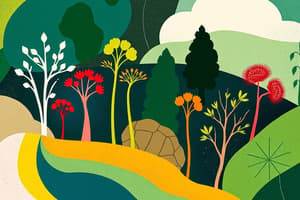Podcast
Questions and Answers
What is the primary focus of ecology?
What is the primary focus of ecology?
- The classification of living organisms
- The interactions between organisms and their physical environment (correct)
- The study of organisms only
- The study of climate change effects on organisms
Which factor is NOT used to categorize biomes?
Which factor is NOT used to categorize biomes?
- Temperature
- Soil type (correct)
- Vegetation
- Precipitation
What components do ecosystems include?
What components do ecosystems include?
- Only abiotic components
- Both biotic and abiotic components (correct)
- Terrestrial components only
- Only biotic components
Which of the following best describes a population?
Which of the following best describes a population?
What is the structure of DNA primarily composed of?
What is the structure of DNA primarily composed of?
What process is responsible for making copies of DNA before cell division?
What process is responsible for making copies of DNA before cell division?
What mainly influences population growth?
What mainly influences population growth?
Which of the following best describes a biome?
Which of the following best describes a biome?
Flashcards
What is Ecology?
What is Ecology?
The study of how living things interact with their environment, including both other organisms and the physical surroundings.
What is a Biome?
What is a Biome?
A large-scale geographical area characterized by its climate, specific plant and animal life, and overall ecosystem. Examples include rainforests, deserts, and tundras.
What is an Ecosystem?
What is an Ecosystem?
A community of living organisms and their physical environment, including both biotic (living) and abiotic (non-living) components.
What is a Population?
What is a Population?
Signup and view all the flashcards
What is DNA?
What is DNA?
Signup and view all the flashcards
What is DNA replication?
What is DNA replication?
Signup and view all the flashcards
What is DNA transcription?
What is DNA transcription?
Signup and view all the flashcards
What is DNA translation?
What is DNA translation?
Signup and view all the flashcards
Study Notes
Ecology
- Ecology is the study of the interactions between organisms and their environment.
- This includes interactions between organisms and other organisms (e.g., predation, competition), and interactions between organisms and their physical environment (e.g., temperature, sunlight, water).
- Ecology is a multidisciplinary field, drawing upon principles from biology, chemistry, physics, and other sciences.
Biomes
- A biome is a large area characterized by a specific climate and the types of plants and animals that live there.
- Biomes are categorized based on factors like temperature, precipitation, and vegetation.
- Examples of biomes include tropical rainforests, deserts, grasslands, taigas, tundra, and deciduous forests.
- Biomes are dynamic systems that are constantly changing due to environmental factors.
- The organisms within a biome are adapted to the specific conditions of that environment.
Ecosystems
- An ecosystem is a community of living organisms (plants, animals, and microorganisms) and their physical environment.
- Ecosystems are dynamic and complex systems where organisms interact with each other and their surroundings.
- Ecosystems include both biotic (living) and abiotic (non-living) components.
- Energy flows through ecosystems through food webs and trophic levels.
- Nutrients are cycled through ecosystems via various processes like decomposition and nutrient uptake.
Populations
- A population is a group of individuals of the same species that live in the same area and can interbreed.
- Populations can be characterized by their size, density, distribution, and growth rate.
- Population growth is influenced by birth rates, death rates, immigration, and emigration.
- Limiting factors such as food, water, and space can restrict population size.
- Factors like disease and predation also affect population dynamics.
DNA
- DNA (deoxyribonucleic acid) is the molecule that carries the genetic instructions used in the development and functioning of all known living organisms.
- DNA is a double helix structure composed of nucleotides, each containing a sugar, a phosphate, and a nitrogenous base (adenine, thymine, guanine, and cytosine).
- The sequence of these bases determines the genetic code.
- DNA replication is the process of making copies of DNA before cell division.
- DNA is transcribed into RNA, which is then translated into proteins, carrying out the genetic instructions.
Photosynthesis
- Photosynthesis is the process by which green plants and some other organisms use sunlight to synthesize foods from carbon dioxide and water.
- It's crucial for producing energy in ecosystems.
- Photosynthesis occurs in chloroplasts, which contain chlorophyll.
- Chlorophyll absorbs light energy, typically from the sun.
- The process releases oxygen as a byproduct.
- Formula: 6CO₂ + 6H₂O + Light Energy → C₆H₁₂O₆ + 6O₂ (Carbon dioxide + Water + Light Energy → Glucose + Oxygen)
Studying That Suits You
Use AI to generate personalized quizzes and flashcards to suit your learning preferences.




